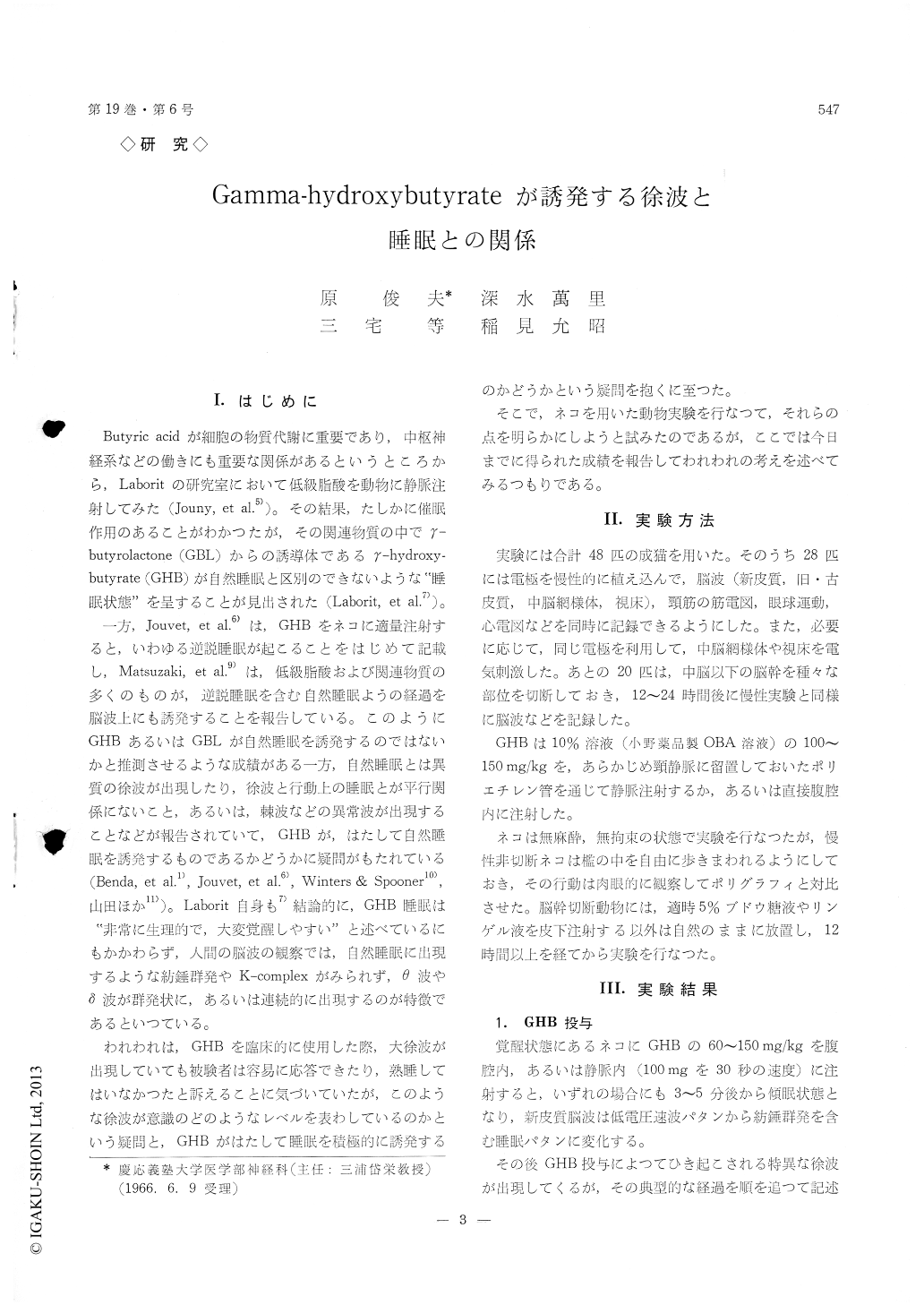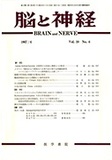Japanese
English
- 有料閲覧
- Abstract 文献概要
- 1ページ目 Look Inside
I.はじめに
Butyric acidが細胞の物質代謝に重要であり,中枢神経系などの働きにも重要な関係があるというところから,Laboritの研究室において低級脂酸を動物に静脈注射してみた(Jouny, et al.5))。その結果,たしかに催眠作用のあることがわかつたが,その関連物質の中でγ—butyrolactone (GBL)からの誘導体であるγ—hydroxy—butyrate (GHB)が自然睡眠と区別のできないような"睡眠状態"を呈することが見出された(Laborit, et al.7))。
一方,Jouvet, et al.6)は,GHBをネコに適量注射すると,いわゆる逆説睡眠が起こることをはじめて記載し,Matsuzaki, et al.9)は,低級脂酸および関連物質の多くのものが,逆説睡眠を含む自然唾眠ようの経過を脳波上にも誘発することを報告している。このようにGHBあるいはGBLが自然睡眠を誘発するのではないかと推測させるような成績がある一方,自然睡眠とは異質の徐波が山現したり,徐波と行動上の睡眠とが平行関係にないこと,あるいは,棘波などの異常波が出現することなどが報告されていて,GHBが,はたして自然睡眠を誘発するものであるかどうかに疑問がもたれている(Benda, et al.1), Jouvet, et al.6), Winters & Spooner10), 山田ほか11))。Laborit自身も7)結論的に,GHB睡眠は"非常に生理的で,大変覚醒しやすい"と述べているにもかかわらず,人間の脳波の観察では,自然睡眠に出現するような紡錘群発やK-complexがみられず,θ波やδ波が群発状に,あるいは連続的に出現するのが特徴であるといつている。
It has been already reported by several authors that the administration of the γ-hydroxybutyrate (GHB) can produce a reversible unconscious state similar to physiological sleep. On the other hand, the high voltage slow waves which are not identical with those observed in the deep sleep or narcosis, are elicited by the drug administration. To clarify the relation between the drug-induced slow waves and sleep state, we carried out cat's experiments observing the beha-vioral changes and polygraphic recordings obtained by the chronically implanted electrodes.
Intraperitoneal injection of the GHB (100~150 mg/kg) produced a generalized synchronization of spontaneous electrical activity. The spindling was present in com-plete form. Within some ten minutes, the high voltage 4~6c/s slow waves appeared and intermingled with the "slow sleep" activities. Therefor, the EEG pattern changed into polymorphous aspect, and the spindling was distoreted and fractionized by the drug-induced slow waves. However, the polygraphic and behavioral manifestations indicated that animal was sleeping.
Meanwhile, a sudden increase of the neck muscle discharge was seen and a train of monorhythmic con-tinuous 1~2c/s high voltage slow wave was observed in the cortical and subcortical EEG. In this state, the eyes were open and pupils slightly dilated. The animal could respond to the external stimuli with movements of eyeballs and/or head, though the animal looked like a catatonia-like state because of lacking spon-taneous movements. A transient desynchronization was observed on the EEG tracing and this pattern was coincided with the moter responses.
In the animal pre-treated with the LSD-25, the same doses of the GHB did not elicite the sleep. The monortythmic slow waves, however, could be observed.
The thalamo-cortical recruiting responses enhanced in the polymorphous EEG state, but they showed marked decrease or disappearance in the monorhythmic slow EEG state.
From these results, it is likely to conclude that the appearance of the GHB-induced slow waves are independent of the sleep mechanism.
The GHB-induced slow waves were not induced when the brain-stem was transected at the prepontine lebel, while the midpontine transected cats showed the said slow waves. Thus, it may be said that the ante-rior part of the pons has an important roll to induce the GHB-induced slow waves.

Copyright © 1967, Igaku-Shoin Ltd. All rights reserved.


